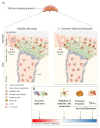From Coxiella burnetii Infection to Pregnancy Complications: Key Role of the Immune Response of Placental Cells
- PMID: 34069587
- PMCID: PMC8160966
- DOI: 10.3390/pathogens10050627
From Coxiella burnetii Infection to Pregnancy Complications: Key Role of the Immune Response of Placental Cells
Abstract
The infection of pregnant animals and women by Coxiella burnetii, an intracellular bacterium, compromises both maternal health and foetal development. The placenta is targeted by C. burnetii, as demonstrated by bacteriological and histological evidence. It now appears that placental strains of C. burnetii are highly virulent compared to reference strains and that placental injury involves different types of placental cells. Trophoblasts, the major placental cells, are largely infected by C. burnetii and may represent a replicating niche for the bacteria. The placenta also contains numerous immune cells, including macrophages, dendritic cells, and mast cells. Placental macrophages are infected and activated by C. burnetii in an unusual way of M1 polarisation associated with bacterial elimination. Placental mast cells eliminate bacteria through a mechanism including the release of extracellular actin filaments and antimicrobial peptides. In contrast, C. burnetii impairs the maturation of decidual dendritic cells, favouring bacterial pathogenicity. Our aim is to review C. burnetii infections of human placentas, paying special attention to both the action and function of the different cell types, immune cells, and trophoblasts targeted by C. burnetii in relation to foetal injury.
Keywords: Coxiella burnetii; dendritic cells; macrophages; mast cells; pregnancy; trophoblasts.
Conflict of interest statement
The authors declare no conflict of interest.
Figures

Similar articles
-
Infection and Persistence of Coxiella burnetii Clinical Isolate in the Placental Environment.Int J Mol Sci. 2023 Jan 7;24(2):1209. doi: 10.3390/ijms24021209. Int J Mol Sci. 2023. PMID: 36674725 Free PMC article.
-
Full-Term Human Placental Macrophages Eliminate Coxiella burnetii Through an IFN-γ Autocrine Loop.Front Microbiol. 2019 Oct 29;10:2434. doi: 10.3389/fmicb.2019.02434. eCollection 2019. Front Microbiol. 2019. PMID: 31749776 Free PMC article.
-
Mast Cell Cytonemes as a Defense Mechanism against Coxiella burnetii.mBio. 2019 Apr 16;10(2):e02669-18. doi: 10.1128/mBio.02669-18. mBio. 2019. PMID: 30992359 Free PMC article.
-
Coxiella burnetii infections in sheep or goats: an opinionated review.Vet Microbiol. 2015 Dec 14;181(1-2):119-29. doi: 10.1016/j.vetmic.2015.07.011. Epub 2015 Jul 15. Vet Microbiol. 2015. PMID: 26315774 Review.
-
Coxiella burnetii Lipopolysaccharide: What Do We Know?Int J Mol Sci. 2017 Nov 23;18(12):2509. doi: 10.3390/ijms18122509. Int J Mol Sci. 2017. PMID: 29168790 Free PMC article. Review.
Cited by
-
Modulation of the E-cadherin in human cells infected in vitro with Coxiella burnetii.PLoS One. 2023 Jun 7;18(6):e0285577. doi: 10.1371/journal.pone.0285577. eCollection 2023. PLoS One. 2023. PMID: 37285354 Free PMC article.
-
Serological and molecular prevalences and phylogenetic analysis of Coxiella burnetii in dogs in Al-Qadisiyah and Baghdad Provinces, Iraq.Vet World. 2024 Nov;17(11):2603-2611. doi: 10.14202/vetworld.2024.2603-2611. Epub 2024 Nov 22. Vet World. 2024. PMID: 39829647 Free PMC article.
-
Molecular examination for Coxiella burnetii and Brucella spp. infections in Iranian women experiencing spontaneous miscarriage.BMC Infect Dis. 2024 Feb 7;24(1):172. doi: 10.1186/s12879-024-09041-5. BMC Infect Dis. 2024. PMID: 38326756 Free PMC article.
-
Infection and Persistence of Coxiella burnetii Clinical Isolate in the Placental Environment.Int J Mol Sci. 2023 Jan 7;24(2):1209. doi: 10.3390/ijms24021209. Int J Mol Sci. 2023. PMID: 36674725 Free PMC article.
-
Pathogenicity and Virulence of Coxiella burnetii: Focus on Q fever.Virulence. 2025 Dec;16(1):2495842. doi: 10.1080/21505594.2025.2495842. Epub 2025 Jun 19. Virulence. 2025. PMID: 40536474 Free PMC article. Review.
References
Publication types
LinkOut - more resources
Full Text Sources

